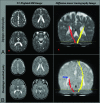Diffusion tensor imaging-demonstrated differences between hemiplegic and diplegic cerebral palsy with symmetric periventricular leukomalacia
- PMID: 22976239
- PMCID: PMC7964924
- DOI: 10.3174/ajnr.A3272
Diffusion tensor imaging-demonstrated differences between hemiplegic and diplegic cerebral palsy with symmetric periventricular leukomalacia
Abstract
Background and purpose: Patients with cerebral palsy have variable clinical presentations such as hemiplegic, diplegic, or quadriplegic patterns though they have PVL on conventional MR images. The authors investigated whether DTT can differentiate between hemiplegic and diplegic CP in patients presenting with symmetric PVL on conventional MR images.
Materials and methods: One hundred thirteen consecutive pediatric patients with definite hemiplegic (59 patients; 30 boys, 29 girls; mean age, 34.19 months; range, 24-52 months) or diplegic (54 patients; 27 boys, 27 girls; mean age, 31.07 months; range, 24-48 months) symptoms and bilateral symmetric PVL on conventional brain MR imaging were recruited. The states of CSTs were examined by using DTT, and the asymmetries of right and left CSTs in the hemiplegic and diplegic groups were compared by using asymmetric anisotropy indexes and asymmetric mean diffusivity indexes.
Results: All patients in the hemiplegic group with asymmetric results exhibited disrupted integrities of more affected CSTs and sparing of less affected CSTs. However, diplegic patients revealed symmetric disrupted findings of the right and left CSTs at the upper periventricular level. Asymmetric anisotropy index and asymmetric mean diffusivity index values were significantly higher in the hemiplegic group than in the diplegic group (P < .05), and these results of DTT significantly corresponded with their typical clinical manifestation.
Conclusions: DTT may be very useful for the detailed estimation of the CST state in patients with bilateral symmetric PVL.
Figures

Similar articles
-
The Neurological Outcome of Isolated PVL and Severe IVH in Preterm Infants: Is It Fair to Compare?Pediatr Neurol. 2015 Nov;53(5):427-33. doi: 10.1016/j.pediatrneurol.2015.04.004. Epub 2015 May 22. Pediatr Neurol. 2015. PMID: 26476149
-
Diffusion tensor imaging demonstrated radiologic differences between diplegic and quadriplegic cerebral palsy.Neurosci Lett. 2012 Mar 14;512(1):53-8. doi: 10.1016/j.neulet.2012.01.065. Epub 2012 Feb 6. Neurosci Lett. 2012. PMID: 22330748
-
Anisotropy of transcallosal motor fibres indicates functional impairment in children with periventricular leukomalacia.Dev Med Child Neurol. 2011 Feb;53(2):179-86. doi: 10.1111/j.1469-8749.2010.03840.x. Epub 2010 Dec 1. Dev Med Child Neurol. 2011. PMID: 21121906 Free PMC article.
-
Incontinentia pigmenti associated with cerebral palsy and cerebral leukomalacia: a case report and literature review.Pediatr Dermatol. 2003 Nov-Dec;20(6):491-4. doi: 10.1111/j.1525-1470.2003.20607.x. Pediatr Dermatol. 2003. PMID: 14651567 Review.
-
Population-based study of neuroimaging findings in children with cerebral palsy.Eur J Paediatr Neurol. 2011 Jan;15(1):29-35. doi: 10.1016/j.ejpn.2010.07.005. Eur J Paediatr Neurol. 2011. PMID: 20869285 Review.
Cited by
-
Changes of Structural Brain Network Following Repetitive Transcranial Magnetic Stimulation in Children With Bilateral Spastic Cerebral Palsy: A Diffusion Tensor Imaging Study.Front Pediatr. 2021 Jan 15;8:617548. doi: 10.3389/fped.2020.617548. eCollection 2020. Front Pediatr. 2021. PMID: 33520901 Free PMC article.
-
Clinical study of cerebral palsy in 408 children with periventricular leukomalacia.Exp Ther Med. 2015 Apr;9(4):1336-1344. doi: 10.3892/etm.2015.2222. Epub 2015 Jan 27. Exp Ther Med. 2015. PMID: 25780432 Free PMC article.
-
Disruption of the Corticospinal Tract in Patients with Acute Lymphoblastic Leukemia: A Case Series.Children (Basel). 2022 Aug 12;9(8):1223. doi: 10.3390/children9081223. Children (Basel). 2022. PMID: 36010113 Free PMC article.
-
Behavioral and histological outcomes following neonatal HI injury in a preterm (P3) and term (P7) rodent model.Behav Brain Res. 2014 Feb 1;259:85-96. doi: 10.1016/j.bbr.2013.10.038. Epub 2013 Nov 1. Behav Brain Res. 2014. PMID: 24185032 Free PMC article.
-
Childhood Acute Lymphoblastic Leukemia Showing Unilateral Motor Dysfunction Prior to Chemotherapy: A Diffusion Tensor Tractography Study.Children (Basel). 2023 Jan 27;10(2):224. doi: 10.3390/children10020224. Children (Basel). 2023. PMID: 36832353 Free PMC article.
References
-
- Fan GG, Yu B, Quan SM, et al. . Potential of diffusion tensor MRI in the assessment of periventricular leukomalacia. Clin Radiol 2006;61:358–64 - PubMed
-
- Wilson-Costello D, Borawski E, Friedman H, et al. . Perinatal correlates of cerebral palsy and other neurologic impairment among very low birth weight children. Pediatrics 1998;102:315–22 - PubMed
-
- Stewart AL, Reynolds EO, Hope PL, et al. . Probability of neurodevelopmental disorders estimated from ultrasound appearance of brains of very preterm infants. Dev Med Child Neurol 1987;29:3–11 - PubMed
-
- Kuban KC, Leviton A. Cerebral palsy. N Engl J Med 1994;330:188–95 - PubMed
-
- Folkerth RD. Periventricular leukomalacia: overview and recent findings. Pediatr Dev Pathol 2006;9:3–13 - PubMed
Publication types
MeSH terms
LinkOut - more resources
Full Text Sources
Medical
Miscellaneous
